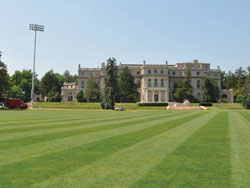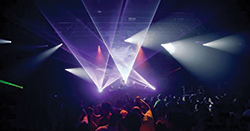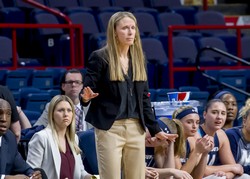After much debate, the University will begin removal of the Great Lawn’s grass field to build a turf field benefiting the University’s soccer teams, club sports programs and recreational activities beginning April 1.
The new field will be named Hesse Field in recognition of the private donation from Marianne Hesse, a member of the University’s Board of Trustees.
As stated on FieldTurf.com, field turf is an artificial playing surface intended to replicate natural grass. The field is composed of a polyethylene fibers layer, an infill layer of silica sand and cryogenic rubber, and a backing layer of woven polypropylene fabric.
According to Marilyn McNeil, Vice President and Director of Athletics, this project, with an estimated $1.4 million budget, is scheduled to be complete by mid-June.
The trustee decided to donate Hesse Field as a gift to her two grandchildren who are currently attending the University, one of whom plays club soccer. “I was blessed to be able to donate,” Hesse said. The Hesse family has been involved with the Board of Trustees for a number of years and has donated previously.
The final plan to convert the field was finalized by the Board of Trustees in February after confirmation of the gift from Hesse was received.
Robert McCourt, head coach of the men’s soccer team, said, “The Great Lawn is such a unique place, and [the turf] will only continue to enhance our ability as a team.”
McCourt believes the turf will serve as a recruiting tool for prospective future athletes. “This replacement will only enhance and enrich the opportunity to bring fantastic players to the University,” he added.
McCourt feels this change will be successful in terms of allowing the University to better host tournaments in the Metro Atlantic Athletic Conference (MAAC) affiliated in National Collegiate Athletic Association (NCAA) Division I. McCourt believes the turf field will relieve stress incurred by constant maintenance of the grass and ease the worry of playing in uncertain northeast weather conditions.
Joseph Schmid, previous captain of the men’s soccer team, said, “Since I got to Monmouth, the grass has been declining every year in no fault to the grounds staff, but all fault to the weather conditions. Grass is ideal, but turf is what is needed…” Turf is used for all professional sports, therefore it is the ideal condition to play games on, Schmid added.
The idea to replace the grass on the Great Lawn with field turf has “always been under discussion,” according to McNeil. Since natural grass has limited use and is difficult to maintain over one season, turf has been discussed as a solution, she added.
University President Dr. Paul Brown announced the upgrade to the Great Lawn through an email to the campus community on Monday, March 3 at approximately 6 am. Brown explained that turf will improve the conditions of the fields which will increase the opportunities for the nationally and internationally recognized University soccer teams. The President said, “It is important to know that these renovations will be done in a way that enhances the beauty of the Great Lawn.”
Pedram Daneshgar, an assistant professor of biology, is not optimistic about the turf field’s appearance. He said, “I believe that the Great Lawn is a part of a historical landmark. How does the University justify destroying it, covering it up with artificial turf? Permanent changes are not made to Wilson Hall for the same reason.”
Daneshgar does, however, believe the change may be beneficial from a financial aspect of cutting costs due to decreased maintenance.
In her sixteenth season as the head coach of the women’s soccer program, Krissy Turner said the team loved having a grass field but believes this shift towards turf is necessary for MAAC. “[Grass] is the true surface that soccer is played on around the world. The aesthetics and how it looks just makes the game incredible.”
Turner believes the home grass field has been an advantage to the women’s soccer team. “Opponents are intimidated by the environment of the Great Lawn, but I don’t think that will change because of the turf,” she continued.
John Egan, a redshirt sophomore, believes that one benefit to playing on a turf field is the ability to better control the bounce of a soccer ball, whereas playing on grass fields can redirect the ball due to ditches and divots.
Because of the material, it is contemplated by health officials whether or not a turf field can increase the likelihood of athletes’ cleats getting stuck and tangled in the artificial grass blades. However, Turner does not believe that there is a potential for injury, due to a lack of evidence. “As long as the athletes are wearing the right shoes and have the right approach to the game, there shouldn’t be an increased concern,” she said.
According to Turner, this past year two players incurred significant knee injuries, with one occurring on an artificial field and the other on the natural grass of the Great Lawn.
These potential injuries lead to the concern of infection. As explained in an article published by EOEarth.org, methicillin-resistant Staphylococcus aureus (MRSA) is thought to spread easily among athletes because of repeated skin-to-skin contact, frequency of cuts, and sharing of equipment.
Chuck Whedon, Associate Athletic Director for Sports Medicine, does not see a bacterial infection as a significant concern since there has been a lack of turf-burn related infection at the University. He said, “Our sports medicine staff inspects, cleanses and dresses the wounds regularly so the risk of infection is minimized. The University’s investment in appropriate medical coverage through adequate staffing who can monitor our student-athletes and manage the turf wounds and other conditions is the main preventative measure.”
Another preventative measure the University can take, as explained by Daneshgar, includes treating the fields with chemicals to eliminate the bacteria. “Water flows laterally on the surface until it can penetrate,” Daneshgar said. “Most of the water on our campus flows southwards where it is deposited into Whale Pond Brook. This causes the stream to be heavily polluted and harmful to aquatic organisms.”
Despite some debatable environmental and health concerns, both McCourt and Turner agree field turf has become common for sports. McCourt said, “Every one of my players has grown up playing on turf, apart from a few of my international guys. More and more teams are playing on artificial turf for the very reasons the University has decided to use it.”
“Although grass is certainly the best surface on which to play, current advances in the both the materials and design of artificial turf surfaces, especially subsurface padding, make them a better overall choice to have available for athletic participation,” said Whedon.
Egan said, “[The turf field] will provide the teams with a permanent field that will remain in all four seasons throughout the year.” In the future, the redshirt sophomore would also like to see improvements made to the fan section, and believes a permanent bleacher or stadium should be constructed. He believes this development would make students more excited to attend games, urge the University to schedule more home games against higher ranked opponents and continue to make the program rise.
Turner believes Hesse Field is another step in the direction of making the Great Lawn seem more professional and exciting. “Hopefully the environment [of Hesse Field] is still intimidating so we can continue to dominate at home on our own turf.”
PHOTO TAKEN from gomuhawks.com




